Amica DT 374 050 W Bruksanvisning
Läs gratis den bruksanvisning för Amica DT 374 050 W (184 sidor) i kategorin kylskåp. Guiden har ansetts hjälpsam av 12 personer och har ett genomsnittsbetyg på 4.6 stjärnor baserat på 6.5 recensioner. Har du en fråga om Amica DT 374 050 W eller vill du ställa frågor till andra användare av produkten? Ställ en fråga
Sida 1/184

Refrigerator-freezer / Kühl-Gefriergerät /
Chladnička-mraznička / Chladnička s mrazničkou
/ Réfrigérateurcongélateur / Koel-vrieskast /
Hladnjak-zamrzivač / Hladilnik-zamrzovalnik
DT 374 050 W
IO-REF-0733
(10.2020)
OPERATING INSTRUCTIONS EN
GEBRAUCHSANWEISUNG DE
NÁVOD K OBSLUZE CS
NÁVOD NA OBSLUHU SK
NOTICE D’UTILISATION FR
GEBRUIKSAANWIJZING NL
UPUTE ZA UPORABU HR
NAVODILO ZA UPORABO SL

- 2 -
GUIDELINES CONCERNING THE SAFETY OF USE 11
INSTALLATION AND OPERATING CONDITIONS OF THE APPLIANCE 16
INSTALLATION BEFORE USING THE APPLIANCE FOR THE FIRST TIME 16
MINIMUM DISTANCES FROM THE HEAT SOURCES 16
MAINS CONNECTION 17
DISCONNECTING THE MAINS 17
CLIMATE RANGE 17
UNPACKING 18
DISPOSAL OF OLD APPLIANCE 19
CONTROLS 20
APPLIANCE CONTROLS 20
ADJUST TEMPERATURE INSIDE THE APPLIANCE 20
ADDITIONAL INFORMATION ON THE TEMPERATURE 21
OPERATION AND FUNCTIONS 22
STORAGE OF FOOD IN THE FRIDGE-FREEZER 22
FREEZING FOOD** 22
USING THE REFRIGERATOR EFFICIENTLY 24
PRACTICAL EVERYDAY TIPS 24
UNDERSTANDING THE STARS 24
PRACTICAL TIPS 25
FOOD THAT SHOULD NOT BE STORED IN A REFRIGERATOR 25
DEFROSTING, WASHING AND MAINTENANCE 26
DEFROSTING THE FRIDGE*** 26
DEFROSTING THE FREEZER** 26
DEFROST THE FREEZER CHAMBER FOLLOWING STEPS:** 27
AUTOMATIC FRIDGE DEFROSTING**** 27
AUTOMATIC FRIDGE DEFROSTING**** 27
WASHING THE FRIDGE AND FREEZER CHAMBERS MANUALLY**** 27
TAKING OUT AND PUTTING IN THE SHELVES***** 27
TAKING OUT AND PUTTING IN THE DOOR SHELF***** 27
TROUBLE-SHOOTING 28
WARRANTY AND AFTER SALES SERVICE 30
WARRANTY 30
EN- Table of contents

- 5 -
DÔLEŽITÉ BEZPEČNOSTNÉ POKYNY 74
INŠTALÁCIA A PREVÁDZKOVÉ PODMIENKY SPOTREBIČA 79
INŠTALÁCIA PRED PRVÝM SPUSTENÍM 79
MINIMÁLNE VZDIALENOSTI OD TEPELNÝCH ZDROJOV 79
PRIPOJENIE NAPÁJANIA 80
ODPOJENIE OD NAPÁJANIA 80
KLIMATICKÁ TRIEDA 80
ROZBALENIE 81
LIKVIDÁCIA ZARIADENÍ 82
OVLÁDANIE 83
OVLÁDANIE ZARIADENIA 83
NASTAVENIE TEPLOTY VO VNÚTRI ZARIADENIA 83
DODATOČNÉ INFORMÁCIE O TEPLOTE 84
OBSLUHA A FUNKCIE 85
UCHOVÁVANIE POTRAVÍN V CHLADNIČKE A MRAZNIČKE 85
ZMRAZOVANIE VÝROBKOV** 85
AKO EKONOMICKY POUŽÍVAŤ CHLADNIČKU 87
PRAKTICKÉ RADY 87
ČO ZNAMENAJÚ HVIEZDIČKY? 87
ZÓNY V CHLADNIČKE 88
PRODUKTY, KTORÉ BY NEMALI BYŤ PRECHOVÁVANÉ V CHLADNIČKE 88
ODMRAZOVANIE, UMÝVANIE A ÚDRŽBA 89
ODMRAZOVANIE CHLADNIČKY*** 89
ODMRAZOVANIE MRAZNIČKY** 89
PRE ODMRAZENIE MRAZIACEHO PRIESTORU MRAZNIČKY JE POTREBA** 90
AUTOMATICKÉ ODMRAZOVANIE CHLADNIČKY**** 90
AUTOMATICKÉ ODMRAZOVANIE MRAZNIČKY**** 90
RUČNÉ UMÝVANIE KOMORY CHLADNIČKY A MRAZNIČKY**** 90
VYŤAHOVANIE A VKLADANIE POLÍC***** 90
VYŤAHOVANIE A VKLADANIE PRIEHRADKY***** 90
LOKALIZÁCIA ZÁVAD 91
ZÁRUKA, POPREDAJNÝ SERVIS 93
ZÁRUKA 93
SK- Obsah

- 6 -
CONSIGNES DE SECURITÉ D’UTILISATION 95
INSTALLATION ET CONDITIONS DE FONCTIONNEMENT DE L’APPAREIL 100
INSTALLATION AVANT LA PREMIÈRE MISE EN MARCHE 100
LES DISTANCES MINIMUMS DES SOURCES DE CHAUFFAGE 100
RACCORDEMENT AU RÉSEAU ÉLECTRIQUE 101
MISE HORS CIRCUIT 101
CLASSE CLIMATIQUE 101
DÉBALLAGE 102
ÉLIMINATION DES APPAREILS USAGÉS 103
UTILISATION ET FONCTIONS 104
CONSERVATION DES DENRÉES DANS LE RÉFRIGÉRATEUR 104
CONGÉLATION DES PRODUITS** 104
COMMANDE 106
COMMANDE DE L’APPAREIL 106
RÉGLAGE DE LA TEMPÉRATURE À L’INTÉRIEUR DE L’APPAREIL 106
INFORMATIONS SUPPLÉMENTAIRES SUR LA TEMPÉRATURE 107
COMMENT EXPLOITER LE REFRIGERATEUR DE FAÇON ECONOMIQUE? 108
CONSEILS PRATIQUES 108
QUE VEULENT DIRE LES ÉTOILES? 108
ZONES DE STOCKAGE DANS LE RÉFRIGÉRATEUR 109
PRODUITS QUI NE DEVRAIENT PAS ÊTRE STOCKÉS DANS LE RÉFRIGÉRATEUR 109
DÉGIVRAGE, NETTOYAGE ET CONSERVATION 110
DÉGIVRAGE DU RÉFRIGÉRATEUR*** 110
DÉGIVRAGE DU CONGÉLATEUR** 110
MODE OPÉRATOIRE POUR LE DÉGIVRAGE DU COFFRE DU CONGÉLATEUR:** 111
DÉGIVRAGE AUTOMATIQUE DU RÉFRIGÉRATEUR**** 111
DÉGIVRAGE AUTOMATIQUE DU CONGÉLATEUR**** 111
LAVAGE À MAIN DU COMPARTIMENT RÉFRIG ÉRATEUR ET CONGÉLATEUR**** 111
ENLÈVEMENT ET MISE EN PLACE DES CLAYETTES ***** 111
ENLÈVEMENT ET MISE EN PLACE DU BALCONNET ***** 111
LOCALISATION DES PANNES 112
GARANTIE, SERVICE APRÈS-VENTE 114
GARANTIE 114
FR- Table des matières

- 7 -
AANWIJZINGEN BETREFFENDE VEILIGHEID VAN GEBRUIK 116
INSTALLATIE EN WERKOMSTANDIGHEDEN VAN HET APPARAAT 121
INSTALLATIE VOOR DE EERSTE INGEBRUIKNAME 121
MINIMALE AFSTANDEN VAN WARMTEBRONNEN 121
AANSLUITEN OP HET ELECTRICITEITSNET 122
UITSCHAKELEN 122
KLIMAATKLASSE 122
UITPAKKEN 123
VERWIJDERING VAN GEBRUIKTE APPARATUUR 124
BEDIENING EN FUNCTIES 125
HET BEWAREN VAN PRODUCTEN IN DE KOELKAST 125
HET INVRIEZEN VAN PRODUCTEN** 125
BEDIENING 127
BEDIENING VAN HET APPARAAT 127
REGELEN VAN DE TEMPERATUUR IN HET APPARAAT 127
AANVULLENDE INFORMATIE BETREFFENDE DE TEMPERATUUR 128
HOE KAN DE KOELKAST ECONOMISCH GEBRUIKT WORDEN? 129
PRAKTISCHE TIPS 129
WAT BETEKENEN DE STERRETJES? 129
ZONES IN DE KOELKAST 130
LEVENSMIDDELEN DIE NIET IN DE KOELKAST BEWAARD MOGEN WORDEN 130
ONTDOOIEN, WASSEN EN ONDERHOUD 131
ONTDOOIEN VAN DE KOELKAST*** 131
ONTDOOIEN VAN DE DIEPVRIEZER** 131
OM DE VRIESRUIMTE TE ONTDOOIEN HANDELT U ALS VOLGT:** 132
AUTOMATISCH ONTDOOIEN VAN DE KOELKAST**** 132
AUTOMATISCH ONTDOOIEN VAN DE DIEPVRIEZER**** 132
HANDWASSEN VAN DE KOELKAST EN DIEPVRIEZER**** 132
UITHALEN EN INZETTEN VAN DE LEGPLATEAUS***** 132
PLAATSEN EN VERPLAATSEN VAN DE OPBERGVAK***** 132
STORINGEN VINDEN EN VERHELPEN 133
GARANTIE, SERVICE 135
GARANTIE 135
NL- Inhoudsopgave

- 8 -
VAŽNE SIGURNOSNE INFORMACIJE 137
INSTALACIJA I UVJETI RADA UREĐAJA 142
INSTALACIJA PRIJE PRVOG POKRETANJA 142
MINIMALNE UDALJENOSTI OD IZVORA TOPLINE 142
UKLJUČIVANJE U ELEKTRIČNU MREŽU 143
ISKLJUČIVANJE IZ ELEKTRIČNE MREŽE 143
KLIMATSKI RAZRED 143
UKLANJANJE PAKIRANJA 144
ZBRINJAVANJE POTROŠENIH UREĐAJA 145
UPRAVLJANJE 146
UPRAVLJANJE UREĐAJEM 146
REGULACIJA TEMPERATURE UNUTAR UREĐAJA 146
DODATNE INFORMACIJE O TEMPERATURI 147
UPORABA I FUNKCIJE 148
POHRANJIVANJE NAMIRNICA U HLADNJAKU I ZAMRZIVAČU 148
ZAMRZAVANJE NAMIRNICA** 148
EKONOMIČNA UPORABA HLADNJAKA 150
PRAKTIČNI SAVJETI 150
ŠTO ZNAČE ZVJEZDICE? 150
ZONE TEMPERATURA U HLADNJAKU 151
NAMIRNICE KOJE NE BI TREBALI ČUVATI U HLADNJAKU. 151
ODLEĐIVANJE, PRANJE I ODRŽAVANJE 152
ODLEĐIVANJE I PRANJE HLADNJAKA *** 152
ODLEĐIVANJE I PRANJE ZAMRZIVAČA** 152
U CILJU ODLEĐIVANJA KOMORE ZAMRZIVAČA:** 153
AUTOMATSKO ODLEĐIVANJE HLADNJAKA**** 153
AUTOMATSKO ODLEĐIVANJE ZAMRZIVAČA**** 153
RUČNO PRANJE HLADNJAKA I ZAMRZIVAČA.**** 153
VAĐENJE I UMETANJE POLICA***** 153
VAĐENJE I UMETANJE POLICE VRATA***** 153
RJEŠAVANJE PROBLEMA 154
JAMSTVO, POSLIJEPRODAJNE AKTIVNOSTI 156
JAMSTVO 156
HR- Kazalo

- 10 -
Dear customer,
From now on, your daily housework will be easier
than ever before. Your appliance is excepon-
ally easy to use and extremely ecient. Aer reading
these Operang Instrucons, operang the appliance
will be easy.
Before being packaged and leaving the manufacturer,
the appliance was thoroughly checked with regard to
safety and funconality.
Before using the appliance, please carefully read
these Operang Instrucons. By following these
instrucons carefully you will be able to avoid any
problems in using the appliance. It is important to
keep these Operang Instrucons and store them in a
safe place so that they can be consulted at any me.
Follow these instrucons carefully in order to avoid
possible accidents.
Sincerely,

- 11 -
GUIDELINES CONCERNING
THE SAFETY OF USE
• The appliance is intended for household use only.
• The manufacturer reserves the right to introduce
changes which do not aect the operation of the
appliance.
• Some provisions in this user manual are unied
for refrigerating products of dierent types (for a
refrigerator, refrigerator-freezer or freezer)
• The Manufacturer shall not be held liable for
damage arising from the failure to observe the
instructions contained in this manual.
• Keep this manual for future reference, or to pass
it over to the next user.
• This appliance is not intended for use by persons
(including children) with limited physical or men-
tal capabilities and persons who lack experience
or familiarity with the appliance.
• Do not allow children to use the appliance. Do
not allow them to play with the appliance. They
must not climb inside the drawers and swing on
the doors.
• The appliance operates properly at the ambient
temperature (see product che). Do not use it in
the cellar, unheated summer cottage during au-
tumn and winter.
• When placing, moving, lifting the appliance, do
not hold the door handles, do not pull the con-
denser at the rear part of the refrigerator and do
not touch the compressor unit.
• When transporting, moving or positioning the
fridge-freezer do not tilt it by more than 40°
from the vertical position. Should such a situa-
tion occur, the appliance should be switched on
after minimum 2 hours from its replacement in
the right position (g.2).

- 13 -
tal or sensory handicaps, or by those who are
inexperienced or unfamiliar with the appliance,
provided they are supervised or have been in-
structed how to safely use the appliance and are
familiar with risks associated with the use of the
appliance. Ensure that children do not play with
the appliance. Cleaning and maintenance of the
appliance should not be performed by children
unless they are 8 years or older and are super-
vised by a competent person.
• In order to obtain more space in the freezer, you
can remove the drawers and place the food di-
rectly on the shelves. This has no eect on the
product mechanical properties and cooling per-
formance. Declared freezer capacity was calcu-
lated with the drawers removed.
WARNING: Risk of re / ammable
materials
• Children aged from 3 to 8 years are allowed to
load and unload refrigerating appliances.
To avoid contamination of food, please respect the
following instructions:
• Opening the door for long periods can cause a
signicant increase of the temperature in the
compartments of the appliance.
• Clean regularly surfaces that can come in contact
with food and accessible drainage systems.
• Store raw meat and sh in suitable containers in
the refrigerator, so that it is not in contact with or
drip onto other food.
• Two-star frozen-food compartments are suitable
for storing pre-frozen food, storing or making ice-
cream and making ice cubes.
• One-, two- and three-star compartments are not
suitable for the freezing of fresh food

- 14 -
Compartments
TYPE
Target storage
temp.[ OC] Appropriate food
1 Fridge +2≤+8
Eggs, cooked food, packaged food, fruits and
vegetables, dairy products, cakes, drinks and
other foods are not suitable for freezing.
2Freezer
!
≤-18
Seafood (sh, shrimp, shellsh), freshwater
aquatic products and meat products
(recommended for 3 months, the longer the
storage time, the worse the taste and nutrition),
suitable for frozen fresh food.
3Freezer
@
≤-18
Seafood (sh, shrimp, shellsh), freshwater
aquatic products and meat products
(recommended for 3 months, the longer the
storage time, the worse the taste and nutrition),
are not suitable for frozen fresh food.
4Freezer
#
≤-12
Seafood (sh, shrimp, shellsh), freshwater
aquatic products and meat products
(recommended for 2 months, the longer the
storage time, the worse the taste and nutrition),
are not suitable for frozen fresh food
5Freezer ≤-6
Seafood (sh, shrimp, shellsh), freshwater
aquatic products and meat products
(recommended for 1 months, the longer the
storage time, the worse the taste and nutrition),
are not suitable for frozen fresh food.
60- star
compartment -6≤0
Fresh pork, beef, sh, chicken, some packaged
processed foods, etc. (Recommended to eat
within the same day, preferably no more than
3 days). Partially encapsulated processed foods
(non-freezable foods)
7 Chill 2≤+3
Fresh/frozen pork, beef, chicken, freshwater
aquatic products, etc.(7 days below 0 OC and above
0OC is recommended for consumption within that
day, preferably no more than 2 days). Seafood
(less than 0 for 15 days, it is not recommended to
store above 0 OC)
8 Fresh Food 0≤+4
Fresh pork, beef, sh, chicken, cooked food,
etc. (Recommended to eat within the same day,
preferably no more than 3 days)
9 +5≤+20Wine red wine,white wine,sparkling wine etc.
• Note: please store dierent foods according to
the compartments or target storage temperature
of your purchased products.

- 15 -
• If the refrigerating appliance is left empty for long
periods, switch o, defrost, clean, dry, and leave
the door open to prevent mould developing with-
in the appliance.
• Water dispenser cleaning (special for water dis-
penser products): Clean water tanks if they have
not been used for 48 h; ush the water system
connected to a water supply if water has not been
drawn for 5 days.
• Pursuant to Commission Regulation (EU)
2019/2019, the minimum availability period for
spare parts necessary to repair the appliance is 7
or 10 years depending on the type and purpose
of the spare part.
• The list of spare parts and the ordering procedure
are available on the websites of the manufactur-
er, importer or an authorized representative.
• For more information about the product, please
refer to the EU EPREL Product Database at https://
eprel.ec.europa.eu. For more information, please
use your mobile device to scan the QR code on
the energy label or enter the product model listed
on the energy label in the EPREL search engine
https://eprel.ec.europa.eu/

- 16 -
INSTALLATION AND OPER-
ATING CONDITIONS OF THE
APPLIANCE
This refrigeration appliance is not intended for use as a built-in appliance.
Installation before using the appliance for the rst time
• Take the product out of the package, remove the scotch tape protect-
ing the door and the equipment. Any remaining adhesive stains may
be removed with a mild washing agent.
• Do not throw away the polystyrene elements of the packaging. If it is
necessary to transport the fridge-freezer, pack it in the polystyrene
elements and lm as well as protect ing it with scotch tape
• Clean the interior surface of the fridge- freezer and the elements of
the equipment with a washing agent dissolved in lukewarm water,
then wipe it dry.
• Place the fridge-freezer on an even, at and stable surface, in dry,
aired and shaded room, far from the heat sources such as: oven,
hob, central heating radiators, central heating pipes, hot water in-
stallation, etc.
• On the exterior surface of the product may be a protective foil, this
foils should be removed.
• Make sure the appliance is placed in a horizontal position by screwing
in the 2 adjustable front legs (g. 3)
• To ensure that the door opens freely, the distance between the side
of the appliance (on door hinges side) and the wall is shown on gure
5.*
• Ensure adequate ventilation of the room and free air circulation from
all sides of the appliance (g. 6).*
Minimum distances from the heat sources
• from the electric gas and other ovens - 30 mm,
• from oil or coal red ovens - 300 mm,
• from built-in ovens - 50 mm
If there is no possibility of ensuring the above- mentioned distances,
provide an appropriate insulation board.
Warning:
• The rear wall of the refrigerator, in particular, the condenser and oth-
er elements of the cooling system must not contact other elements,
which may damage them, (e.g. central heating pipes and the water
supply pipes).
• It is forbidden to readjust or modify any parts of the unit. It is crucial
not to damage the capillary tube visible in the compressor recess.
The tube may not be bent, straightened or wound.
• If the capillary tube is damaged by the user the guarantee will be
void (g. 8).
• In some models the handle is put into the appliance, You should
screw it with Your own screwdriver,

- 17 -
Mains connection
• Prior to connection, it is recommended to set the temperature control
knob to an „OFF” or other position that disconnects the appliance
from the power supply (See page with the control description).
• This appliance should be connected to AC 220-240V 50Hz supply
socket. The socket must be tted properly, and must be supplied with
an earthing conduit and a 10A fuse.
• It is a legal requirement that the appliance is properly earthed. The
manufacturer will not be held liable for any damage or injury which
may result from the failure to full this requirement.
• Do not use adapters, multiple sockets and two-wire extension leads.
If it is necessary to use the extension lead, it must be equipped with
a protection ring and a single socket and must have a VDE/GS safety
certicate.
• If an extension lead is used (with a protection ring and safety certif-
icate), its socket must be located at a safe distance, away from the
sinks, and must not be in a place where it could be ooded by water
or waste water.
• See the type plate at the lower part of the internal wall of the appli-
ance for detailed specications**.
Disconnecting the mains
Make sure the appliance can be easily disconnected from the mains,
either by pulling the plug out of the mains socket, or by switching the
two-pole switch o (g. 9).
Climate range
The information about the climate range of the appliance is provided
on the rated plate. It indicates at which ambient temperature (that is,
room temperature, in which the appliance is working) the operation of
the appliance is optimal (proper).
Climate class Allowable ambient temperature
SN Extended Temperate
This refrigeration appliance is intended for use
at an ambient temperature ranging between
10°C and 32°C
N Temperate
This refrigeration appliance is intended for use
at an ambient temperature ranging between
16 °C and 32°C
ST Subtropical
This refrigeration appliance is intended for use
at an ambient temperature ranging between
16 °C and 38 °C
T Tropical
This refrigeration appliance is intended for use
at an ambient temperature ranging between
16 °C and 43 °C
* Only free-standing appliances
** According to the model

- 19 -
DISPOSAL OF OLD
APPLIANCE
In accordance with European Directive
2012/19/EU and local legislation re-
garding used electrical and electronic
goods, this appliance is marked with
the symbol of the crossed-out waste
container. This marking indicates that
the appliance must not be disposed
of together with other household waste after it has
been used.
The user is obliged to hand it over to waste collec-
tion centre collecting used electrical and electron-
ic goods. The collectors, including local collection
points, shops and local authority departments pro-
vide recycling schemes.
Proper handling of used electrical and electronic
goods helps avoid environmental and health haz-
ards resulting from the presence of dangerous com-
ponents and the inappropriate storage and process-
ing of such goods.

- 20 -
CONTROLS
Appliance controls
The control panel is shown in gure 10. For reference it is also shown
below:
Adjust temperature inside the appliance
Turn the dial to adjust the temperature in the appliance:
OFF/0 position Appliance is o
Setting 1 The highest temperature inside the appliance
(warmer)
Settings 2-5 Medium temperature inside the appliance
Setting 6 The lowest temperature inside the appliance
(cooler)
Note:
• The temperature control dial in your appliance can be marked dif-
ferently than in this manual. The general principle of operation is
described above.
• If there is no position marked "OFF" or "0” on the dial, turn o your
appliance by unplugging the power cord from the wall outlet. Before
unplugging set the lowest setting on the temperature control dial.

- 21 -
Additional information on the temperature
• The temperature inside the appliance is inuenced by many factors.
How you set the temperature control dial depends on the ambient
temperature, sun exposure, how often you open the door and the
amount of food stored. The middle setting of the dial is most optimal
in most cases.
• Do not put food into the fridge freezer before it has reached its oper-
ating temperature, which takes minimum 4 hours.
• Do not change the temperature settings due to the change in the
season of the year. The ambient temperature increase will be detect-
ed by the sensor and the compressor will be switched on automati-
cally for a longer period of time in order to maintain the temperature
set inside the chambers.
• The slight changes in temperature are perfectly normal and may oc-
cur, for instance during the storage of great quantities of fresh prod-
ucts in the fridge, or when the door is open for a longer period of
time. This will not aect the condition of the stored foodstu, and the
temperature will quickly return to its set value.

- 22 -
OPERATION AND FUNCTIONS
Storage of food in the fridge-freezer
• The products should be placed on plates, in containers or packed in
food wrap. Distribute them evenly over the shelves.
• If the food contacts the rear wall, it may cause frosting or wetting of
the products.
• Do not put dishes with hot food into the fridge
• Products which absorb avours easily such as butter, milk, white
cheese and products with intense avour, such as sh, smoked meat,
hard cheese must be placed on shelves, packed in food wrap or in
tightly sealed containers.
• The storage of vegetables containing signicant quantities of water
will cause the deposition of condensation on the vegetable contain-
ers, it does not impact on the proper functioning of the fridge.
• Before putting the vegetables into the fridge, dry them well.
• Excessive moisture shortens the shelf life of vegetables, especially
the leafed vegetables.
• Do not wash the vegetables before storing in the refrigerator. Wash-
ing removes the natural protection, therefore it is better to wash the
vegetables directly before consumption.
• It is recommended to place the products in freezer drawers 1, 2, 3*
up to natural loading capacity (Fig. 11a / 11b).**
1. Packed products
2. Shelf
3. Natural loading capacity
4.
!
• Stacking of products on the freezer shelves is acceptable.*
• It is acceptable to place products beyond the natural loading capacity
by 20-30 mm.**
• In order to increase the loading capacity of the freezer chamber and
allow the stacking of products on the freezer evaporator wire shelves
up to maximum height it is possible to remove drawers 1 and 2.*
Freezing food**
• Practically all the food products, except for vegetables consumed
raw, such as lettuce can be frozen.
• Only food products of the highest quality, divided into small portions
for single use, should be frozen.
• Products should be packed in materials that are odourless, resistant
to air and moisture penetration, and not susceptible to fat. Plastic
bags, polyethylene and aluminium sheets are the best wrapping ma-
terials.
• -The packaging should be tight and should stick to the frozen prod
ucts. Do not use glass containers.
• Keep fresh and warm foodstu at ambient temperature away from
the products, which have already been frozen.
• We advise you not to place more of fresh food at a time to the freezer
per day (see table witch technical specication).

- 24 -
USING THE REFRIGERATOR
EFFICIENTLY
Practical everyday tips
• Do not place fridges or freezers next to radiators, heaters, stoves or
in direct sunlight.
• Make sure that air vents are not covered up and clean the dust o
them once or twice a year.
• Select the right temperature: 6 to 8°C in your refrigerator and -18°C
in your freezer is sucient.
• When on holiday, turn up the temperature in your fridge.
• Only open your fridge or freezer when necessary. It helps if you know
what food each contains and where it is located. Return food to the
fridge or freezer as soon as possible after you have used it so that it
does not warm up too much.
• Wipe the inside of your fridge regularly with a cloth soaked in a mild
detergent. Appliances which are not self-defrosting will require regu-
lar defrosting. Do not allow frost layers thicker than 10 mm to form.
• Keep the seal around the door clean, otherwise it will not shut prop-
erly. Always replace broken seals.
Understanding the stars
Temperature is at least -6°C; sucient to store frozen food
for about a week. Drawers or compartments marked with
one star used to be a feature of (mostly) cheaper fridges.
#
Food can be stored at -12°C or below for 1-2 weeks without
losing its taste. Not suitable for freezing food.
@
This rating is mainly used to store foods at -18°C or below.
Can also be used to freeze up to 1 kilogram of fresh food.
!
This appliance is suitable for storing foods at -18°C or be-
low and freezing larger quantities of fresh foods.

- 26 -
DEFROSTING, WASHING AND
MAINTENANCE
Never clean the product’s casing or plastic parts using solvents or strong,
abrasive detergents (e.g. washing powders or creams)! Use mild liquid
detergents and soft cloths only. Do not use sponges.
Defrosting the fridge***
• Frost settles on the rear wall of the fridge chamber. It is removed
automatically. During the defrosting, the condensate, which contains
contaminants may clog the opening in the through. Should it occur,
carefully unclog the opening with the cleaning plug (g. 13).
• The appliance operates in cycles: it refrigerates (then the frost set-
tles on the rear wall), and defrosts (water ows down the rear wall)
• Disconnect the appliance from the mains before cleaning by remov-
ing the plug from the mains socket or switching o the fuse. Prevent
water from penetrating the control panel or the light.
• Do not use defrosting aerosols. They may cause the formation of an
explosive mixture, or contain solvents which may damage the plastic
components of the appliance and even be harmful to health.
• -Make sure the water used for cleaning does not ow into the evapo
ration container through the discharge opening.
• The whole appliance, except for the door gasket must be cleaned
with a mild cleaning detergent. The door gasket should be cleaned
with water and wiped dry.
• Wash all the accessories (vegetable containers, door shelves, glass
shelves, etc.).
Defrosting the freezer**
• It is recommended to combine defrosting the appliance with washing
it.
• Excessive accumulation of ice on the freezing areas impairs the ap-
pliance’s freezing capacity and increases the energy consumption.
• Defrost the appliance at least once or twice a year. In case of a higher
ice build-up, defrosting must be carried out more frequently.
• If there is food in the freezer, set the knob to the max. position about
4 hours before the planned defrosting. This will ensure the possibility
of storing the food at the ambient temperature for a longer time.
• After taking the food out of the freezer, put it in a container, wrap it
with several layers of paper, a blanket and store it at a cool place.
• The defrosting operation should last as short as possible. Long stor-
age of food at the ambient temperature shortens their shelf life.

- 27 -
Defrost the freezer chamber following steps:**
• Switch of the appliance using the control panel and pull the plug out
from the socket..
• Open the door and remove the food from the freezer.
• Depending on the model, pull out the drainage tube located in the
bottom of the freezer compartment and place a suitable vessel un-
derneath.
• Leave the door open, this will speed up the defrost process. Addi-
tionally, a pot with hot water (not boiling) may be placed inside the
freezer compartment.
• Wash the interior of the freezer and wipe it dry.
• Switch on the appliance as per the relevant point in the manual.
Automatic fridge defrosting****
The fridge chamber has been equipped with an automatic defrosting
function. However, frost may settle on the rear wall of the fridge cham-
ber. This happens usually, when large quantities of fresh food products
are stored in the fridge.
Automatic fridge defrosting****
The freezer chamber has been equipped with an automatic defrosting
function (no-frost). The food is frozen in the cooled circulation air, and
the moisture from the freezer chamber is discharged outside. As a result,
no ice and frost is produced in the freezer and the products do not freeze
on each other.
Washing the fridge and freezer chambers manually****
It is recommended to wash the fridge and freezer chambers at least once
a year. This prevents the formation of bacteria and bad odours. Switch
o the appliance, using button (1), remove the food from the chambers
and wash them using water with a mild detergent. Then, wipe the cham-
bers dry with a cloth.
Taking out and putting in the shelves*****
Slide the shelf out, then slide it in as much as possible so that its clamp
could t the guide groove (g. 15).
Taking out and putting in the door shelf*****
Lift the door shelf, remove it and put it back from the top into its required
position (g. 16).
WARNING! You must not put an electric heater, a heating fan or a hair
dryer into the freezer by any means.
** Applicable to appliances with a freezer compartment
!
Not applicable to appliances with a Frost-free System.
*** Applicable to appliances with a refrigerator compartment
Not applicable to appliances with a Frost-free System.
**** Applicable to appliances with a Frost-free System.
***** Does not apply to freezers

- 28 -
TROUBLE-SHOOTING
Problems RemediesPossible causes
The appliance does not work The electric circuit is dis-
rupted
- check whether the plug is
properly inserted into the
socket
- check whether the power
cable of the appliance is not
damaged
- check whether there is
voltage in the socket, by
plugging another appliance,
e.g. a night lamp
- check whether the ap-
pliance is switched on by
setting the thermostat to a
position above 0.
The lighting inside the
chamber does not work
The bulb is loose or fused
(only appliances with bulb
lightning type)
- t the bulb correctly or
replace it (see section above
“Replacing the interior light
bulb)
The appliance works contin-
uously
Incorrect setting of the
adjustment knob
- reset the knob to a lower
position
See. ”Temperature inside
the appliance is not low
enough for description of
other possible causes
See. ”Temperature inside
the appliance is not low
enough for description of
other possible remedies
Water collects in the lower
part of the appliance
The water discharge open-
ing is clogged (depending
on the model)
- clean the discharge
opening (see the operating
manual – chapter entitled
”Defrosting the fridge”)
Internal air circulation ob-
structed
- place the food and con-
tainers in such a way as
that they do not touch the
rear wall of the fridge
The appliance generates
unusual noise
Incorrect levelling of the
appliance
- level the appliance prop-
erly
The appliance is touch-
ing furniture and/or other
objects
- place the appliance at a
location that ensures proper
clearances around it

- 29 -
Problems RemediesPossible causes
Temperature inside the
appliance is not low enough
or too high
Incorrect setting of the
adjustment knob
- reset the knob to a higher
position
The ambient temperature is
higher or lower than the cli-
mate range from table with
technical specication
- the appliance is adapted
to operation in the climate
range from table with tech-
nical specication.
The appliance is located in
a sunlit place or near heat
sources
- move the appliance to
another place. Observe the
guidelines contained in the
manual
Too much warm food loaded
at a time
- wait 72 hours until the
food becomes cool (freezes)
and the required tempera-
ture is reached inside the
chamber
Internal air circulation ob-
structed
- place the food and con-
tainers in such a way that
they do not touch the rear
wall of the fridge
The air circulation at the
back of the appliance is
obstructed
- move the appliance min.
30 mm away from the wall
The door of the fridge/freez-
er is opened too often and/
or remains open for too long
- reduce the frequency of
opening the door and/or
shorten the time when door
remains open
The door does not close
completely
- place the food and con-
tainers so that they would
not interfere with door
closed
The compressor is switched
on too rarely
- check whether the ambi-
ent temperature is not lower
than climate class
Door gasket inserted incor-
rectly - press the gasket in
Certain sounds can be heard during normal use of the refrigerator, which
do not aect its correct operation.
Sounds, which can be easily prevented:
• noise caused by the appliance which is not level - adjust the position
with the adjustable turn-in front feet. Alternatively, place pads made
of soft material under the rear rollers, especially when the appliance
is placed on tiles.
• touching the adjacent piece of furniture - move the refrigerator away.
• creaking of the drawers or shelves - take out and put back the drawer
or shelf.
• sounds of clinking bottles - move bottles apart.
Sounds heard during normal use are mainly due to operation of the ther-
mostat, compressor (switching on) and cooling system (thermal expan-
sion and contraction of the radiator caused by ow of the cooling agent).

- 30 -
WARRANTY AND AFTER
SALES SERVICE
Warranty
Warranty service as stated on the warranty card. The manufacturer shall
not be held liable for any damage caused by improper use of the product.
Service
• The manufacturer recommends that all repairs and adjustments be
carried out by the Factory Service Technician or the Manufacturer’s
Authorized Service Point. For safety reasons, repairs should be re-
ferred to professionals.
• Repairs carried out by unqualied persons may seriously endanger
the appliance user.
• The minimum warranty period for the appliance oered by the man-
ufacturer, importer or authorized representative is given in the war-
ranty card.
• The warranty shall be void if you make any independent adaptations
or alterations, tamper with seals or other appliance safety devices
or its parts or interfere with the appliance contrary to operating in-
structions.
In the event of appliance malfunction, request assistance or repair.
If your appliance needs repair, please contact the service centre. Please
see warranty card for address and contact details of our service centre.
Before contacting us, please have ready the appliance serial number,
which can be found on the identication sticker: For your convenience,
please write it down below:
Manufacturer’s Declaration
The manufacturer hereby declares that this product meets the re-
quirements of the following European directives:
• Low Voltage Directive 2014/35/EC
• Electromagnetic Compatibility (EMC) Directive 2014/30/EC
• ErP Directive 2009/125/EC
• Directive RoHS 2011/65/EC
and has thus been marked with the symbol and been issued with
a declaration of compliance made available to market regulators.

- 32 -
SICHERHEITSHINWEISE
• Das Gerät ist ausschließlich für den Einsatz im Haus-
halt bestimmt.
• Der Hersteller behält sich das Recht vor, Änderun-
gen vorzunehmen, die Gerätefunktion nicht beein-
trächtigen.
• Manche Bestimmungen dieser Bedienungsanleitung
wurden für die Kühlgeräte verschiedener Art (für
den Kühlschrank, Kühl-Gefriergerät oder Gefrier-
gerät) vereinheitlicht. Die Information über die Art
Ihres Gerätes ist dem Produktdatenblatt, das dem
Gerät beigelegt wurde, zu entnehmen.
• Der Hersteller haftet nicht für die Schäden, die Folge
der Nichteinhaltung inder vorliegenden Gebrauchs-
anweisung angeführten Prinzipien sind.
• Bewahren Sie diese Gebrauchsanweisung auf, um
sie in Zukunft auszunutzenoder einem eventuellen
Nachbesitzer übergeben zu können.
• Das Gerät darf nicht durch Personen (darunter auch
Kinder) mit eingeschränkten körperlichen, sinnli-
chen oder psychischen Fähigkeiten sowie durch un-
erfahrene sowie solche Personen, die das Gerät nicht
kennen, bedient werden, es sei denn, es geschieht
unter Aufsicht oder gemäß der Anweisungen der für
ihre Sicherheit verantwortlichen Personen.
• Erlauben Sie nicht den Kindern das Gerät ohne Auf-
sicht zu bedienen. Erlauben Sie den Kinder nicht mit
dem Gerät zu spielen. Lassen Sie die Kinder nicht
sich auf die aufschiebbaren Bestandteile des Kühl-
schranks zu setzen oder auf der Kühlschranktür zu
hängen.
• Das Kühl-Gefriergerät arbeitet ordnungsgemäß bei
einer Raumtemperatur, die in der Tabelle mit der
technischen Spezikation angegeben ist. Das Gerät
ist nur für den Gebrauch in Innenräumen geeignet,
allerdings nicht in unbeheizten Kellerräumen, Haus-
uren oder Sommerhäusern.
• Zum Aufstellen und Verschieben des Gerätes dürfen
nie die Türgrie, die Kondensatorröhrchen oder die
Kompressoreinheit benutzt werden.
• Das Kühl- und Gefriergerät sollte während des Trans-

- 34 -
• Das Gerät kann von Kindern ab 8 Jahren und Perso-
nen mit eingeschränkten physischen, sensorischen
oder geistigen Fähigkeiten oder mit mangelnder Er-
fahrung und Unkenntnis verwendet werden, wenn
sie in die sichere Verwendung des Geräts eingewie-
sen wurden und sie die mit ihm verbundenen Gefah-
ren verstanden haben. Kinder dürfen nicht mit dem
Gerät spielen. Die Reinigung und Wartung des Ge-
rätes dürfen von Kindern nicht erfolgen, es sei denn,
dass sie das 8. Lebensjahr vollendet haben und von
einer zuständigen Person beaufsichtigt wurden.
• Um mehr Platz im Gefriergerät zu bekommen, kön-
nen die Schubladen herausgenommen und die Pro-
dukte direkt in die einzelnen Fächer gelegt werden.
Die thermischen und mechanischen Eigenschaften
des Gerätes werden hiervon nicht betroen. Der
deklarierte Nutzinhalt des Gefriergerätes wurde bei
herausgenommenen Schubladen ermittelt.
WARNHINWEIS: Brandgefahr / brennba-
re Stoe
• Kinder im Alter von 3 bis 8 Jahren können Produkte
in das Kühlgerät legen oder herausnehmen.
Um die Kontamination von Lebensmitteln zu vermei-
den, halten Sie sich an folgende Regeln:
• Lassen Sie die Tür nicht zu lange oen, da sonst die
Temperatur in den Kühlfächern beachtlich ansteigen
kann.
• Reinigen Sie die mit Lebensmitteln in Kontakt kom-
menden Flächen sowie gegebenenfalls die zugängli-
chen Wasserabläufe regelmäßig.
• Bewahren Sie rohes Fleisch und Fisch in den da-
für vorgesehenen Kühlfächern auf, sodass sie nicht
mit anderen Lebensmittel in Kontakt kommen und
kein Fleisch- oder Fischsaft auf andere Lebensmittel
tropft.
• Die 2-Sterne-Fächer im Gefrierschrank dienen zur
Lagerung von Tiefkühlprodukten, zum Aufbewahren
oder Einfrieren von Eis sowie für die Herstellung von
Eiswürfeln.

- 36 -
8
Fach für die
Aufbewahrung
von frischen
Lebensmitteln
0≤+4
Frisches Schweineeisch, Rindeisch, Fisch,
Hähnchen, gekochte Produkte etc. (am besten
am selben Tag und maximal innerhalb von 3
Tagen verzehren).
9Weinfach Rot- und Weißwein, Sekt etc.+5≤+20
• Hinweis: lagern Sie die Produkte gemäß den Anwei-
sungen für die Fächer oder gemäß den Lagertempe-
raturen für die Produkte.
• Wenn der Kühlschrank über längere Zeit nicht be-
nutzt wird und leer steht, müssen Sie ihn abschal-
ten, abtauen, auswaschen, trocknen und die Tür
oen lassen, damit sich im Inneren kein Schimmel
bildet.
• Reinigung des Wasserspenders (bei Produkten mit
Wasserspender): Reinigen Sie die Wasserbehälter,
wenn sie über 48 Stunden nicht benutzt wurden;
wenn das Wasser 5 Tage lang nicht abgelassen wur-
de, spülen Sie die an das Wasserleitungsnetz ange-
schlossene Anlage aus.
• Der Mindestzeitraum, für den zur Reparatur des Ge-
räts erforderlichen Ersatzteile erhältlich sind, beträgt
je nach Art und Zweck des Ersatzteils 7 oder 10 Jah-
re und entspricht der Verordnung (EU) 2019/2019
der Kommission.
• Die Ersatzteilliste und das Bestellverfahren nden
Sie auf den Websites des Herstellers, des Einführers
und des Vertragshändlers.
• Weitere Informationen über das Produkt bietet die
EU-Produktdatenbank EPREL auf der Website htt-
ps://eprel.ec.europa.eu. Sie nden die Informatio-
nen, indem Sie den QR-Code auf dem Energieetikett
scannen oder das auf dem Energieetikett angege-
bene Produktmodell in die EPREL-Suchmaschine auf
der Website https://eprel.ec.europa.eu/ eingeben.

- 38 -
• Der Türgri bendet sich bei einigen Modellen im Innern des Geräts
und muss noch montiert werden.
Elektrischer Anschluss
• Vor Inbetriebnahme des Geräts stellen Sie die Temperaturregelung
auf „OFF“ oder in eine Position, die das Gerät vom Stromnetz trennt
( s. Steuerungsbeschreibung)
• Das Gerät ist an eine 230V / 50 Hz Wechselstromleitung über eine
vorschriftsmäßig installierte, geerdete und durch eine 10A –Siche-
rung geschützte Steckdose anzuschließen.
• -Das Gerät erfüllt die VDE – Norm. Der Hersteller lehnt jede Haf
tung für eventuell entstandene Schäden ab, deren Ursachen auf das
Nichtbefolgen dieser Vorschrift zurückzuführen sind.
• Keine Adapter, Mehrfachstecker oder zweiadrige Verlängerungskabel
ohne Nullleiter verwenden. Sollte ein Verlängerungskabel nötig sein,
muss es der VDE/GS – Norm entsprechen.
• Verlängerungsschnur verwendet wird, muss sich die Steckdose in ei-
nem sicheren Abstand zu Amarturen mit iessendem Wasser ben-
den.
• Die Daten auf dem Typenschild, das im Inneren des Kühlschranks
angebracht ist, sind unbedingt zu beachten**.
Gerät vom Stromnetz trennen
Das Gerät muss problemlos vom Stromnetz zu trennen sein, indem man
den Stecker herauszieht oder den zweipoligen Schalter betätigt. (Abb.
9).
KLIMAKLASSE
Die Information über die Klimaklasse des Gerätes bendet sich auf dem
Typenschild. Sie zeigt, in welcher Umgebungstemperatur (d.h. Tempe-
ratur des Raumes, in dem das Gerät betrieben wird) das Gerät optimal
funktioniert.
Klimaklasse Zulässige Umgebungstemperatur
SN subnormal Das Kühlgerät ist für Umgebungstemperaturen
von 10 °C bis 32 °C geeignet.
N normal Das Kühlgerät ist für Umgebungstemperaturen
von 16 °C bis 32 °C geeignet.
ST subtropisch Das Kühlgerät ist für Umgebungstemperaturen
von 16 °C bis 38 °C geeignet.
T tropisch Das Kühlgerät ist für Umgebungstemperaturen
von 16 °C bis 43 °C geeignet.
* Gilt nicht für Einbau-Geräte
** Modell abhängig

- 39 -
AUSPACKEN
Das Gerät wird gegen Transportschä-
den geschützt. Nach dem Auspacken
sind die Verpackungsmaterialien so
zu entsorgen, dass dadurch kein Risi-
ko für die Umwelt entsteht.
Alle Materialien, die zur Verpackung
verwendet werden, sind umweltver-
träglich, können hundertprozentig wiederverwertet
werden und sind mit entsprechendem Symbol ge-
kennzeichnet.
Hinweis! Die Verpackungsmaterialien (Polyethylen-
beutel, Styroporstücke usw.) sind beim Auspacken
außer Kinderreichweite zu halten.

- 41 -
STEUERUNG
Steuerung des Gerätes
Das Bedienfeld der Dunstabzugshaube wurde auf der Abbildung Nr. 10
dargestellt und zur Erinnerung gibt es dieses auch nachstehend:
Einstellung der Temperatur im Gerät
Durch die Änderung der Position des Drehreglers erfolgt die Änderung
der Temperatur im Gerät:
Position OFF/0 Das Gerät ist ausgeschaltet.
Position 1 Im Gerät herrscht die höchste Temperatur (im
Inneren ist es wärmer)
Positionen 2-5 Im Gerät herrscht eine mittlere Temperatur.
Position 6 Im Gerät herrscht die niedrigste Temperatur
(im Inneren ist es kälter)
Achtung:
• Der Drehregler des Thermostats in Ihrem Gerät kann anders skaliert
werden, als es nachfolgend dargestellt wurde. Das allgemeine Funk-
tionsprinzip wurde vorstehend geschildert.
• Ist die Position „OFF” oder „0” in Ihrem Gerät nicht vorhanden, ist
die Ausschaltung des Gerätes durch Trennen des Gerätes von der
Stromversorgung (Ziehen des Steckers) möglich. Vor Abschalten den
niedrigsten Wert im Thermostat einstellen.

- 42 -
Weitere Informationen zur Temperatur
• Die Temperatur im Gerät wird von vielen Faktoren abhängig. Die
Stellung des Drehreglers ist unter anderem von der Umgebungstem-
peratur, Grad der Sonneneinwirkung, Häugkeit des Önens der Tür
und des Gerätes, Menge der Lebensmittel abhängig. In den meisten
Fällen ist die Stellung der Drehreglers in der Mitte optimal.
• Den Kühl-und Gefrierraum frühestens 4 Stunden nach Inbetriebnah-
me des Gerätes füllen.
• Eine manuelle Änderung der Innentemperatur auf Grund der Jah-
reszeit ist nicht nötig. Die Erhöhung der Umgebungstemperatur wird
durch den Temperaturfühler erkannt, was eine automatische Inbe-
triebnahme des Verdichters auslöst und damit die Betriebstempera-
tur langfristig stabil hält.
• Geringe Temperaturschwankungen sind eine normale Erscheinung
die beispielsweise durch die Einlagerung vieler frischer Lebensmittel
oder zu langes Önen der Tür auftreten können. Der eingestellte
Temperaturwert wird üblicherweise schnell wieder erreicht.

- 43 -
BEDIENUNG UND FUNKTIO-
NEN
Aufbewahren der Lebensmittel im Kühl- und Gefrierraum
• Die Lebensmittel sollten auf Tellern, in Behältern oder in für Lebens-
mittel bestimmte Folie verpackt aufbewahrt werden. Sie sind gleich-
mäßig auf den Abstellächen zu verteilen.
• Es ist zu beachten, dass die Lebensmittel die hintere Kühlraumwand
nicht berüh- ren, da es sonst zur Reif- oder Feuch- tigkeitsbildung auf
dem Gefriergut kommen kann.
• Keine heissen Speisen in den Kühlschrank legen.
• Lebensmittel, die leicht fremde Gerüchen annehmen, und solche mit
einem starken Eigengeruch sind in den Kühlfächern in Folienverpa-
ckung oder festverschliessbaren Gefässen aufzubewahren.
• Gemüse mit einem hohen Wassergehalt kann die Freisetzung von
Wasserdampf verursachen, der jedoch die Kühlfunktion nicht beein-
trächtigt.
• Vor dem Einlegen in den Kühlraum muss das Gemüse gut abgetrock-
net werden.
• Ein übermäßiger Wassergehalt im Kühlgut (Blattgemüse) verkürzt
die Aufbewahrungszeit.
• Vor dem Einlegen in den Kühlraum darf das Gemüse nicht gewaschen
werden, da das Waschen einen natürlichen Schutz beseitigt. Deswe-
gen empehlt es sich, das Gemüse erst vor dem Verzehr zu waschen.
• Die Produkte sind in die Körbe 1, 2 und 3* zu legen, bis die natürliche
Befüllungsgrenze erreicht ist (Abb. 11a / 11b).**
1. VerpackteProdukte
2. Flaschenablage
3. Natürliche Befüllungsgrenze
4.
!
• Die Lagerung von Produkten in den Draht- fächern des Kühl-
schrank-Verdampfers ist zulässig.*
• -Produkte in den einzelnen Fächern dürfen 2 – 3 cm über der Befül
lungsgrenze gelagert werden.**
• Um mehr Lagerungsraum im Gefrierfach zu erhalten, kann man die
Schubfächer 1 und 2 entfernen und die Produkte in die Metallregale
des Verdampfers legen.*
Tiefkühlung der Lebensmittel**
• Fast alle Lebensmittel eignen sich zum Einfrieren, ausgenommen roh
zu verzehrendes Gemüse, z.B. Blattsalat.
• Nur hochqualitative Lebensmittel sind zum Einfrieren geeignet. Das
Gefriergut sollte kleinportioniert sein.
• Lebensmittel sind in geruchfreies, luft- und feuchtigkeitsdichtes,
sowie fett- und- laugenunempndliches Material zu verpacken. Po-
lyethylen- und Aluminiumfolie sind am besten geeignet.
• Die Verpackung muss dicht sein und an dem Gefriergut fest anliegen.
Glasbehälter sind nicht zu verwenden.
• Es wird empfohlen, bereits eingefrorene Produkte so zu lagern, dass
sie mit den einzufrierenden, frischen Lebensmitteln keine Berührung
haben.

- 44 -
• -Es wird empfohlen, die Menge der zum Einfrieren vorgesehenen Fri
schprodukte entsprechend der technischen Gegebenheiten des Ge-
räts (s. Tabelle) zu berechnen.
• Wir empfehlen, die gefrorenen Portionen auf eine Seite der Gefrier-
kammer zu schieben und die frischen Portionen auf die andere Seite
zu legen.
• Zum Einfrieren der Produkte den mit diesen Zeichen markierten
Raum
!
benut- zen.
• Die Temperatur im Gefrierraum ist von folgenden Faktoren abhängig:
Aussentemperatur, Befüllung des Kühlschrankes, häuges Türenö-
nen, Menge des abgelagerten Reifbeschlags und die Einstellung des
Thermostaten.
• Lässt sich die Tür nicht sofort nach dem Schliessen wieder önen ,
empehlt es sich, 1 bis 2 Minuten zu warten, bis sich der entstandene
Unterdruck ausgeglichen hat.
Die Aufbewahrungszeit der tiefgekühlten Produkte ist von ihrer Quali-
tät sowie der Aufbewahrungstemperatur abhängig. Bei einer Temperatur
von -18°C oder niedriger sollte folgende Aufbewahrungsdauer eingehal-
ten werden:
Produkte Monate
Rindeisch 6-8
Kalbseisch 3-6
Innereien 1-2
Schweineeisch 3-6
Geügel 6-8
Eier 3-6
Fisch 3-6
Gemüse 10-12
Obst 10-12
Das Schnellgefrierfach ist fürs Aufbewahren tiefgefrorener Lebensmittel
nicht geeignet. In diesem Fach können Eiswürfel hergestellt und aufbe-
wahrt werden.
Hinweis: Wenn das Gerät kein Gefrierfach
!
besitzt, bedeutet das,
dass der Kühlschrank nicht zum Einfrieren von Lebensmitteln geeignet
ist.
* Gilt für Geräte mit einem Gefrierfach im unteren Bereich des Gerätes.
** Gilt für Geräte mit einem Gefrierfach
!
*** Gilt nicht für Geräte mit einem Gefrierfach gekennzeichnet mit
!

- 45 -
ENERGIESPARENDE NUTZUNG
DES KÜHLSCHRANKS
Praktische Ratschläge
• Tiefkühltruhe nicht in der Nähe von Heiz- körpern oder Backöfen auf-
stellen und nicht direkter Sonneneinstrahlung aussetzen.
• Sicherstellen, dass die Belüftungsönun- gen nicht verdeckt sind.
Ein- bis zweimal pro Jahr sind die Belüftungsönungen von Staub zu
reinigen.
• Die richtige Temperatur einstellen: Eine Temperatur von 6 bis 8°C im
Kühlschrank und -18°C im Tiefkühlfach sind ausrei- chend.
• Bei längerer Abwesenheit, z.B. im Urlaub, ist die Temperatur im Kühl-
schrank zu er- höhen.
• Ein unnötiges Önen der Tür des Kühl- oder Tiefkühlschranks ist zu
vermeiden. Unverbrauchte Produkte sind so schnell wie möglich wie-
der in den Kühl- oder Tiefkühlschrank zurückzulegen, bevor sie sich
erwärmen.
• Das Innere des Kühlschranks ist regelmäßig mit einem in Reinigungs-
mittel getränkten Lappen auszuwischen. Geräte ohne automatische
Abtaufunktion müssen regelmäßig abgetaut werden. Die Entste-
hung einer Eisschicht von mehr als 10 mm muss vermieden werden.
• Die Türdichtung ist sauberzuhalten, ansonsten schließt die Tür nicht
vollständig. Eine beschädigte Dichtung muss ausgewechselt werden.
Was bedeuten die Sterne?
Bei einer Temperatur von -6°C können tiefegekühlte Le-
bensmittel ungefähr eine Woche lang aufbewahrt werden.
Mit einem Stern gekennzeichnete Schu- bladen oder Fächer
sind (meistens) in preiswerteren Noname-Kühlschränken
zu nden.
#
Bei einer Temperatur von -12°C können Lebensmittel für
1-2Wochen ohne Geschmacksverlust gela- gert werden.
Diese Temperatur ist jedoch für das Einfrieren von Lebens-
mitteln nicht ausreichend.
@
Zum Einfrieren von Lebensmitteln werden hauptsächlich
Temperaturen unter -18°C verwendet. Dies ermöglicht das
Einfrieren von frischen Lebensmitteln mit einem Gewicht
bis zu 1 kg.
!
So gekennzeichnete Geräte ermögli- chen die Aufbewah-
rung von Lebensmit- teln bei einer Temperatur von unter
-18°C und das Einfrieren größerer Mengen an Lebensmit-
teln.

- 47 -
ABTAUEN, REINIGEN UND
PFLEGEN
Zum Reinigen des Gehäuses und der Kunststoteile des Erzeugnisses
keine Lösungsmittel sowie scharfe und Scheuerreinigungsmittel anwen-
den (z.B. Reinigungsmittel- bzw. –milch)! Nur delikate üssige Mittel und
weiche Tücher verwenden. Keine Schwämme verwenden.
Abtauen des Kühlraumes***
• An der hinteren Kühl- raumwand lagert sich Reif ab, der automatisch
abgetaut wird. Beim Abtauen können mit den Kondensattropfen auch
Verunreinigungen in die Trichterönung der Rinne gelangen und da-
durch die Ablassönung verstopfen. Um dies zu verhindern, sollte
diese mit Hilfe des mitgelieferten Reinigungsinstruments vorsichtig
durchstochen werden (Abb.13)
• Das Gerät arbeitet zyklisch: Während des Kühlprozesses lagert sich
an der hinteren Wand ein Reifbeschlag ab. Dieser wird abgetaut, das
Wasser sammelt sich in der Auangvorrichtung.
• Vor dem Reinigen sollte das Gerät durch das Herausziehen des Ste-
ckers aus der Steckdose,durch das Ausschalten oder durch das He-
rausnehmen der Sicherung vom Stromnetz getrennt werden. Nicht
zulassen, dass das Wasser in die Bedien- blende oder Beleuchtung
gelangt.
• Wir empfehlen, keine Auftaumittel in Sprayform zu verwenden. Sie
können die Entstehung von explosiven Aerosolen verursachen. Lö-
sungsmittel, die die Plastikteile des Gerätes schädigen, enthalten oft
auch gesundheitsgefährdende Substanzen.
• Kein Reinigungswasser darf durch die Ablassönung in den Abdampf-
behälter gelangen.
• Das gesamte Gerät, ausgenommen die Türdichtung, sollte mit einem
milden Reinigungsmittel gereinigt werden. Die Türdichtung nur mit
klarem Wasser abwischen und trocknen lassen.
• Alle Ausstattungselemente sollen sorgfältig gereinigt werden (Obst-
und Gemüsefach, Türfächer, Glasplatten, usw.).
Abtauen des Gefrierraumes**
• Es wird empfohlen, das Gerät regelmäßig abzutauen und zu reinigen.
• Eisablagerungen an den Gefrierächen vermindern die Ezienz des
Gerätes und bewirken eine Steigerung des Energieverbrauchs.
• Es empehlt sich, das Gefriergerät minde- stens ein- oder zweimal
im Jahr abzutau- en. Sollte sich mehr Eis bilden, sollte man das Auf-
tauen öfter durchführen.
• Benden sich Lebensmittel im Gefrierraum, so ist der Temperatur-
regler 4 Stunden vor dem geplanten Abtauen auf „max.” zu stellen.
Dadurch wird die Aufbewahrung des Gefrierguts bei Raumtemperatur
während einer längeren Zeit möglich.
• Das Gefriergut aus dem Gefrierraum he- rausnehmen, in eine Schüs-
sel legen, mit einigen Schichten Zeitungspapier und einer Wolldecke
umwickeln und an einer kühlen Stelle aufbewahren.
• Das Abtauen sollte möglichst schnell erfolgen. Wenn die Lebensmittel
über einen längeren Zeitraum bei Raumtemperatur aufbewahrt wer-
den, verkürzt sich ihre Haltbarkeite

- 48 -
Abtauendes Gefrierraumes:**
• -Schalten Sie das Gerät mit dem Steuerungspaneel ab und anschlie
ßend ziehen Sie den Netzstecker aus der Steckdose.
• DieTür önen, die Produkte herausnehmen.
• Je nach dem Modell ziehen Sie den Abusskanal im hinteren Bereich
des Kühlgerätes und stellen Sie ein Gefäß darunter.
• Lassen Sie die Tür oen, dadurch erfolgt das Auftauen schneller. In
die Kammer des Gefriergerätes kann zusätzlich ein Gefäß mit heißem
(aber nicht kochendem) Wasser gestellt werden.
• Das Geräte innere auswischen und trocknen lassen.
• Das Gerät gemäß entsprechendem Kapitel der Gebrauchsanweisung
wieder einschalten.
Automatische Abtauung des Kühlraumes****
Der Kühlraum ist mit einer automatischen Abtaufunktion ausgestattet.
An der hinteren Kühlraumwand
kann sich jedoch ein Reifbeschlag
ablagern. Es kommt vor allem vor, wenn im Kühlraum viele frische le-
bensmittel aufbewahrt werden.
Automatische Abtauung des Gefrierraumes****
Der Kühlraum ist mit einer automatischen No-Frost-
Abtaufunktion ausgestattet. Die Lebensmittel werden durch die gekühlte
Umluft eingefroren, die Feuchtigkeit wird aus dem Gefrierraum nach Au-
ßen abgeführt. Im Gefrierraum entsteht daher kein Eis- und Reifbeschlag
und die Lebensmittel frieren nicht fest.
Reinigen des Kühl- und Gefrierraumes****
Es empehlt sich das Kühl- und Gefrierraum mindestens einmal im Jahr
zu waschen.
Es wirkt vorbeugend gegen die Entstehung unangenehmer Gerüche so-
wie der Bak- terien. Das Gerät durch das drücken des Knopfes „1“ aus-
schalten, die Lebensmittel herausnehmen und das Gerät mit einem mil-
den. Reinigungsmittel waschen und trocknen lassen.
Einbau und Ausbau der Abstellplatten *****
Abstellplatte herausnehmen und an- schließend an der gewünschten
Stelle bis zum Widerstand einschieben, so dass sich der Schnappver-
schluss in der Füh- rungsleiste bendet (Abb. 15).
Einbau und Ausbau der Türfächer *****
Türfach anheben, herausziehen und von oben in die gewünschte Position
einlegen (Abb. 16).
Auf keinen Fall dürfen im Inneren des Gefrierraumes elektrische Heizkör-
per, Heißluftgebläse oder Haartrockner eingesetzt werden.
** Gilt für Geräte mit einem Gefrierfach
!
.
Gilt nicht für Geräte mit dem Frostfrei-System
*** Gilt für Geräte mit einem Kühlbereich.
Gilt nicht für Geräte mit dem Frostfrei-System
**** Gilt für Geräte mit dem Frostfrei-System
***** Gilt nicht für Gefriergeräte

- 49 -
LOKALISIERUNG VON
STÖRUNGEN
Störung Mögliche Ursachen Behebung
Das Gerät funktioniert nicht Unterbrechung im Strom-
kreis
- Überprüfen, ob der Netz-
stecker gut in der Steckdose
des Speisenetzes sitzt.
- Überprüfen, ob das An-
schlußkabel nicht beschädigt
ist.
- Durch Anschließen ei-
nes anderen elektrischen
Verbrauchers (z.B. einer
Nachttischlampe) überprü-
fen, ob die Steckdose unter
Spannung steht.
- Überprüfen Sie, ob das Ge-
rät eingeschaltet ist (Ther-
mostat in Betriebsstellung).
Innenbeleuchtung funktio-
niert nicht
Die Glühlampe ist gelöst oder
durchgebrannt (in Geräten
mit Glühlampen)
- Vorerst den vorherigen
Punkt überprüfen (das Ge-
rät funktioniert nicht - die
Glühlampe festdrehen oder
auswechsen (in Geräten mit
Glühlampen)
Das Gerät ist ununterbro-
chen in Betrieb
Falsche Temperatureinstellng - einen niedriegeren Wert
einstellen
Andere Ursachen wie unter
Punkt ”Die Temperatur in
den Räumen ist nicht niedrig
genug“
- befolgen Sie die Anweisun-
gen unter Punkt ”Die Tempe-
ratur in den Räumen ist nicht
niedrig genug“
Im unterem Teil des Kühlrau-
mes sammelt sich Wasser
Die Ablaßönung ist ver-
stopft (betrit Geräte mit
Entwässerungsönung)
- Mit Hilfe des Räumwerkin-
stru-ments die Ablaßönung
durchstechen (siehe Ge-
brauchsanweisung, Kapite
Eine freie Luftzirkulation im
Kühlraum ist nicht möglich
- Die Lebensmittel und
Behälter von der Hinterwand
wegrücken.
Es treten für das Gerät un-
gewöhnliche Geräusche auf
Das Gerät ist nicht eben
ausgerichtet - Das Gerät ausrichten.
Das Gerät kommt mit Mö-
beln oder anderen Gegen-
ständen in Berührung
- Das Gerät frei aufstellen,
so daß es keine andere Ge-
genstände berührt.

- 50 -
Störung Mögliche Ursachen Behebung
Die Temperatur in den Räu-
menist nicht niedrig genug
Falsche Temperatur-einstel-
lung
-Einen höheren Wert ein-
stellen
Höhere oder niedrigere
Umgebungstemperatur als
in den technischen Daten
(s.Tabelle) angegeben
- Das Gerät ist angepasst an
die Temperatur, die in den
technischen Daten (s.Tabel-
le) angegeben ist
Das Gerät steht an einer di-
rekt von der Sonne bestrahl-
ten Stelle oder neben einer
Wärmequelle
- Das Gerät an einer anderen
Stelle gemäß Gebrauchsan-
weisung aufstellen.
Es wurde eine zu große Men-
ge von warmen Lebensmit-
teln auf einmal eingelagert
- Warten Sie bis zu 72 Stun-
den , bis die Lebensmittel
eingefroren sind und die
erwünschte Temperatur im
Kühlraum erreicht ist.
Keine freie Luftzirkulation im
Kühlraum
- Die Lebensmittel und
Behälter von der Hinterwand
abrücken
Der Luftuß hinter dem Ge-
rät ist blockiert
- Das Gerät mindestens 3 cm
von der Wand wegrücken.
Die Kühlraum-/ Gefrier-
raumtür wird zu oft geönet
und/oder bleibt zu lange
oen
Beides muss unbedingt ver-
mieden werden
Die Tür lässt sich nicht
schließen
Die Lebensmittel und Behäl-
ter anders platziern
Der Verdichter schaltet
selten an
- prüfen, ob die Umge-
bungstemperatur nicht nied-
riger ist als der Klimaklasse
des Gerätes entspricht
Die Türdichtung wurde falsch
angebracht - Die Türdichtung einpressen
Beim normalen Betreiben der Kälteanlagen können Geräusche unter-
schiedlicher Art auftreten, die keinen Einuss auf den Betrieb des Kühl-
schranks haben.
Geräusche, die leicht zu beheben sind:
• Lautes Betriebsgeräusch , wenn der Kühlschrank nicht senkrecht
steht – Stellung durch die Stellschrauben vorne verändern. Eventuell
unter die Rollen hinten weichen Sto legen, vor allem, wenn das Ge-
rät auf einem Fliesenboden steht.
• Reibung an benachbarte Möbel – Kühlschrank abrücken, so dass er
frei steht.
• Quietschen von Fächern und Schubladen – Fach oder Schublade he-
rausnehmen und wieder einschieben.
• Geräusche von sich berührenden Flaschen – Flaschen voneinander
verschieben.
Geräusche, die bei normalem Betrieb zu hören sind, entstehen durch den
Thermostaten, wenn sich der Kompressor einschaltet, sich das Kühlsys-
tem zusammenzieht oder ausdehnt und wenn Temperaturschwankungen
aufgrund des Durchusses von Kühlmittel in den Röhrchen entstehen.
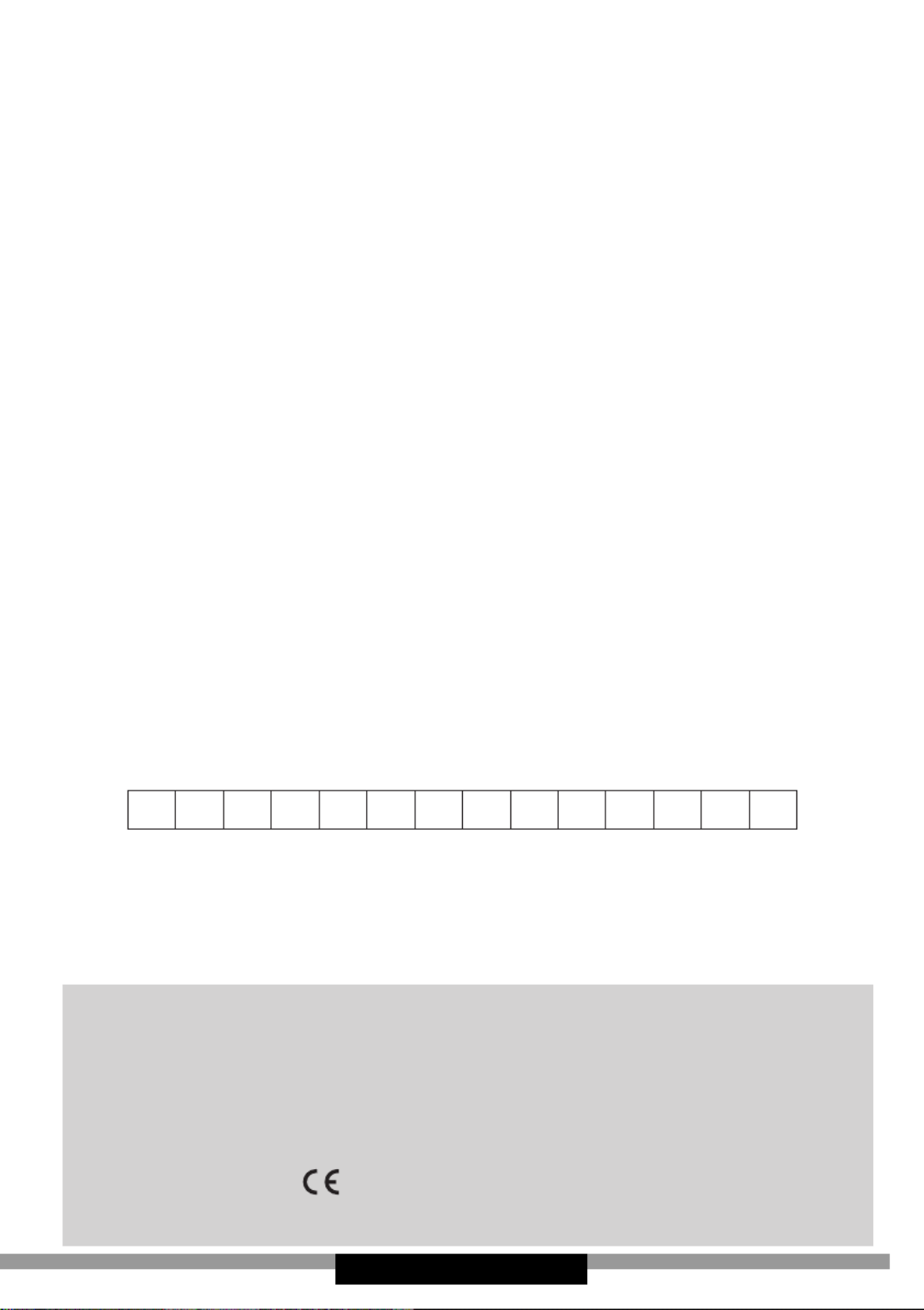
- 51 -
GARANTIE, NACHVERKAUF-
SERVICE
Garantie
Garantieleistungen laut Garantieschein. Der Hersteller übernimmt keine
Haftung für Schäden, die durch den unsachgemäßen Betrieb des Pro-
dukts entstanden sind.
Wartung
• Der Hersteller empehlt, jegliche Reparaturen und Einstellarbeiten
von einem Werksservice oder vom Hersteller autorisierten Kunden-
dienst durchführen zu lassen. Aus Sicherheitsgründen sollten Sie das
Gerät nicht selbst reparieren.
• Von Personen ohne die erforderlichen Qualikationen durchgeführte
Reparaturen können für den Gerätebenutzer eine ernste Gefahr ver-
ursachen.
• Die vom Hersteller, Einführer oder Vertragshändler gewährte Min-
destgarantiezeit für das Gerät ist im Garantieschein angegeben.
• Im Fall unbefugter Anpassungen, Änderungen, der Verletzung von
Plomben oder anderer Sicherheitsvorrichtungen des Geräts oder Tei-
len davon, sowie im Fall sonstiger unbefugter Manipulationen am
Gerät, die nicht der Bedienungsanleitung entsprechen, verfällt die
Garantie für das Gerät.
Reparaturmeldungen und Hilfe bei Fehlern
Wenn das Gerät repariert werden muss, wenden Sie sich bitte an den
Kundendienst. Die Adresse und Rufnummer des Kundendienstes sind im
Garantieschein angegeben. Halten Sie, wenn Sie den Kundendienst an-
rufen, bitte die Seriennummer des Geräts bereit. Diese bendet sich auf
dem Typenschild. Notieren Sie sich die Seriennummer der Einfachheit
halber am besten hier:
CE-Konformitätserklärung
Der Hersteller dieses Produktes erklärt hiermit in alleiniger Verantwortung,
dass dieses Produkt den einschlägigen, grundlegenden Anforderungen der
nachfolgenden EU-Richtlinien entspricht:
• Niederspannungsrichtlinie 2014/35/EG
• Elektromagnetische Verträglichkeit 2014/30/EG
• ErP – Richtlinie 2009/125/EG
• Richtlinie RoHS 2011/65/EG
Das Gerät ist mit dem Zeichen gekennzeichnet und verfügt über eine
Konformitätserklärung zur Einsichtnahme durch die zuständigen Marktüberwa-
chungsbehörden.

- 52 -
Vážený
kliente,
počínaje dnešním dnem jsou každodenní povinnos
jednodušší než kdykoli jindy. Zařízení je spoje-
ním výjimečně snadné obsluhy a vynikající efekvity.
Po přečtení návodu nebudete mít problém s obslu-
hou.
Zařízení, které opuslo továrnu, bylo důkladně zkon-
trolováno před zabalením z hlediska bezpečnos a
funkčnos na kontrolních stanovišch.
Před uvedením zařízení do provozu si pozorně přečtě-
te návod k obsluze. Dodržováním pokynů uvedených
v návodu předejdete nesprávnému používání. Návod
si ponechejte a uschovejte tak, abyste jej měli vždy při
ruce.
Dodržujte přesně návod k obsluze, abyste zabránili
nešťastným událostem.
S úctou

- 54 -
• Chladnička s mrazničkou se nemá naklánět v
úhlu nad 40° od středové osy během přepravy,
přenášení nebo umísťování. Pokud vznikla taková
situace, spotřebič se může zapnout po uplynutí
minimálně 2 hodin od jeho umístění (obr. 2).
• Před každou údržbovou činností je třeba vytáh-
nout zástrčku ze síťové zásuvky. Nemá se tahat
za kabel, ale chytat za kostru zástrčky.
• Slyšitelné zvuky jako bublání nebo praskání jsou
způsobeny roztahováním a smršťováním součástí
v důsledku teplotních změn.
• S ohledem na bezpečnost se spotřebič nemá
opravovat svépomocí. Opravy prováděné osoba-
mi, které nemají požadované kvalikace, mohou
vytvořit vážné nebezpečí pro uživatele spotřebiče
• V případě poškození chladicího okruhu je třeba
na několik minut vyvětrat místnost, ve které se
nachází spotřebič (tato místnost musí mít ales-
poň 4m³; pro spotřebič s izobutanem /R600a).
• Výrobky, i když jen částečně rozmrazené, nelze
znovu zmrazovat.
• Nápoje v lahvích a plechovkách, zejména nápoje
sycené oxidem uhličitým, se nemají uchovávat v
mrazicím prostoru mrazničky. Plechovky a lahve
mohou popraskat.
• Nemají se dávat do úst zmrazené výrobky ihned
po vyjmutí z mrazničky (zmrzliny, kostky ledu,
atp.), jejich nízká teplota může způsobit bolesti-
vé omrzliny.
• Je třeba dávat pozor, aby nedošlo k poškození
chladicího okruhu, např. napíchnutí kanálků kon-
denzátu na výparníku, zalomení trubek. Vstřiko-
vané chladicí médium je hořlavé. V případě vnik-
nutí do očí je třeba vypláchnout je vodou a ihned
přivolat lékaře.
• Jestliže bude napájecí vodič poškozený, musí být
vyměněný v specializovaném opravářském pod-
niku.
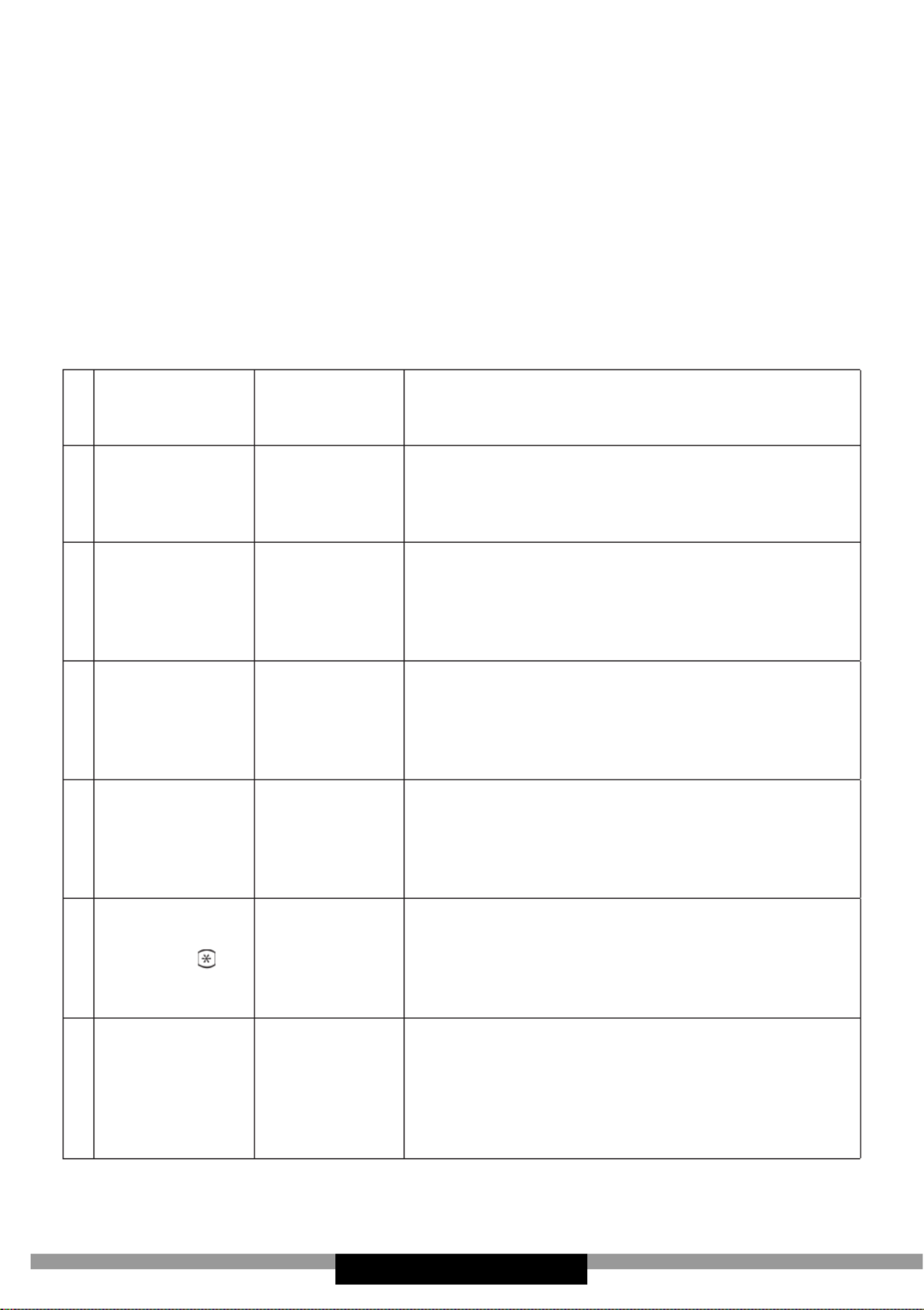
- 56 -
mi potravinami a nekapalo z nich na jiné potra-
viny.
• Dvouhvězdičkové prostostory mrazničky slouží
k uchovávání dříve zmražených potravin, pře-
chovávání nebo mražení zmrzliny anebo mražení
kostek ledu.
• Jednohvězdičkové, dvouhvězdičkové a tříhvěz-
dičkové prostory, neslouží k mražení čerstvých
potravin.
Druhy prostorů
Koncová teplo-
ta uchovávání
[OC]
Vhodné potraviny
1 Chladnička +2≤+8
Vajíčka, vařené potraviny, zabalené potraviny,
ovoce a zelenina, mléčné výrobky, moučníky,
nápoje a jiné produkty, které nejsou vhodné k
mražení.
2Mraznička
!
≤-18
Mořské plody (ryby, krevety, měkkýše), sladko-
vodní produkty a masné výrobky (doporučeno
3 měsíce, čím delší doba uskladnění, tím méně
chutný a výživný bude produkt), vhodné na mra-
žené čerstvé produkty.
3 Mraznička
@
≤-18
Mořské plody (ryby, krevety, měkkýše), sladko-
vodní produkty a masné výrobky (doporučeno
3 měsíce, čím delší doba uskladnění, tím méně
chutný a výživný bude produkt), nevhodné na
mražené čerstvé produkty.
4 Mraznička ≤-12
Mořské plody (ryby, krevety, měkkýše), sladko-
vodní produkty a masné výrobky (doporučeno
2 měsíce, čím delší doba uskladnění, tím méně
chutný a výživný bude produkt), nevhodné na
mražené čerstvé produkty.
5Mraznička ≤-6
Mořské plody (ryby, krevety, měkkýše), sladko-
vodní produkty a masné výrobky (doporučeno
1 měsíc, čím delší doba uskladnění, tím méně
chutný a výživný bude produkt), nevhodné na
mražené čerstvé produkty.
6Bezhvězdičkový
prostor -6≤0
Čerstvé vepřové maso, hovězí maso, ryby, kuřecí
maso, některé balené zpracované produkty, atd.
(doporučená spotřeba, ve stejný den, nejlé-
pe nejpozději do maximálně 3 dnů). Částečně
balené a zpracované produkty (produkty, které
nejsou vhodné k mražení)

- 57 -
7 Chladící prostor 2≤+3
Čerstvé/mražené vepřové maso, hovězí maso,
kuřecí maso, sladkovodní produkty, atd. (7 dnů
pod 0°C, nad 0°C doporučena je spotřeba toho
samého dne, nejlépe maximálně v průběhu 2
dnů). Mořské plody (pod 0°C po dobu 15 dní, ne-
doporučuje se uchovávání v teplotě nad 0°C)
8
Prostor k ucho-
vávání čers-
tvých potravin
0≤+4
Čerstvé vepřové maso, hovězí maso, ryby,
kuřecí maso, vařené produkty, atd. (doporučená
spotřeba, ve stejný den, nejlépe nejpozději do
maximálně 3 dnů).
9Prostor k ucho-
vávání vína +5≤+20 Červené, bílé, perlivé víno atd.
• -Upozornění: je nutné uchovávat produkty shod
ně s doporučením pro prostory, nebo dle teploty
uchovávání produktů.
• Pokud chladící zařízení nebude využíváno a bude
prázdné po delší dobu, je nutno ho vypnout, roz-
mrazit, umýt, vysušit a ponechat s otevřenými
dveřmi, aby předejít plísním uvnitř zařízení.
• Čištění dávkovače vody (pro produkty s dávkova-
čem vody): Vyčistit nádoby na vodu pokud neby-
ly používány přes 48 hodin; pokud voda nebyla
vypuštěna přes 5 dní, opláchnout vodní instalace
připojenou k vodovodní síti.
• -Minimální období, v němž jsou dostupné náhrad
ní díly potřebné na opravu spotřebiče, činí 7 nebo
10 let podle druhu a určení náhradního dílu a je
v souladu s Nařízením komise (EU) 2019/2019.
• Seznam náhradních dílů a procedura objednávání
jsou k dispozici na webových stránkách výrobce,
dovozce nebo oprávněného zástupce.
• Další informace o výrobku se nacházejí v unijní
databázi výrobků EPREL na adrese https://eprel.
ec.europa.eu. Informace lze získat načtením QR
kódu z energetického štítku nebo zadáním mode-
lu výrobku z energetického štítku do vyhledávače
EPREL https://eprel.ec.europa.eu/

- 59 -
Připojení napájení
• Před připojením se doporučuje nastavit otáčecí kolečko regulátoru
teploty do polohy „OFF” anebo jiné, způsobující odpojení spotřebiče
od napájení (viz strana s popisem ovládání).
• -Spotřebič je třeba připojit k síti střídavého proudu 220-240V/ 50Hz
správně zapojenou elektrickou zásuvkou s uzemněním a jištěnou 10
A pojistkou.
• Uzemnění spotřebiče je vyžadováno právními předpisy. Výrobce se
zříká jakékoliv odpovědnosti z titulu eventuálních škod, které mohou
utrpět osoby nebo předměty v důsledku nesplnění povinností stano-
vených tímto předpisem.
• Nesmí se používat spojovací články, několikanásobné zásuvky (roz-
váděče), dvoužilové prodlužovací kabely. Pokud je nutné použití pro-
dlužovacího kabelu, může to být pouze prodlužovací kabel s ochran-
ným kolíkem, jednozásuvkový, který má bezpečnostní atest VDE/GS.
• Pokud bude použit prodlužovací kabel (s ochranným kolíkem, který
má bezpečnostní značku), pak jeho zásuvka musí být umístěna v
bezpečné vzdálenosti od dřezů a nemůže být vystavena na zalití vo-
dou a různými odpady.
• Údaje jsou uvedené na výkonovém štítku umístěném dole na vnitřní
stěně chladicího prostoru chladničky**.
Odpojení od napájení
Je třeba zajistit možnost odpojení spotřebiče od elektrické sítě vytaže-
ním zástrčky nebo vypnutím dvojpólového vypínače (obr. 9).
KLIMATICKÁ TŘÍDA
Informace o klimatické třídě spotřebiče se nachází na výkonovém štít-
ku. Štítek stanoví, při jaké okolní teplotě(tj. místnosti, ve které pracu-
je) spotřebič funguje optimálně (správně).
Klimatická
třída: Přípustná okolní teplota
SN subnormální Chladicí zařízení je určeno k provozu v teplotě
okolí v rozsahu 10 °C až 32 °C
N normální Chladicí zařízení je určeno k provozu v teplotě
okolí v rozsahu 16 °C až 32 °C
ST subtropická Chladicí zařízení je určeno k provozu v teplotě
okolí v rozsahu 16 °C až 38 °C
T tropická Chladicí zařízení je určeno k provozu v teplotě
okolí v rozsahu 16 °C až 43 °C
* Netýká se spotřebičů do vestavění
** V závislosti od modelu

- 60 -
VYBALENÍ
Zařízení bylo po dobu přepravy za-
bezpečeno proti poškození. Po vy-
balení zařízení odstraňte části obalu
způsobem, který neohrožuje životní
prostředí.
Všechny materiály použité na obal
jsou stoprocentně neškodné pro ži-
votní prostředí a jsou vhodné pro zpětné získání a
byly označeny příslušným symbolem.
Upozornění! Obalové materiály (polyetylenové sáč-
ky, pěnový polystyren apod.) nenechávejte při vy-
balování v dosahu dětí.

- 61 -
LIKVIDACE
OPOTŘEBOVANÝCH ZAŘÍZENÍ
Toto zařízení je označeno v souladu s
evropskou směrnicí 2012/19/ES. Ta-
kové označení znamená, že toto zaří-
zení se po ukončení životnosti nesmí
vyhazovat společně s jiným domác-
ním odpadem.
Uživatel je povinen odevzdat jej do
sběrny použitých elektrických a elektronických za-
řízení. Provádějící sběr, včetně místních sběren, ob-
chodů a obecních úřadů, tvoří systém umožňující
odevzdávání těchto zařízení.
Příslušné nakládání s použitými elektrickými a elek-
tronickými zařízeními zabraňuje negativním násled-
kům pro lidské zdraví a životní prostředí, vznikajícím
z přítomnosti nebezpečných složek a nesprávného
skladování a zužitkování takových zařízení.
Produktspecifikationer
| Varumärke: | Amica |
| Kategori: | kylskåp |
| Modell: | DT 374 050 W |
Behöver du hjälp?
Om du behöver hjälp med Amica DT 374 050 W ställ en fråga nedan och andra användare kommer att svara dig
kylskåp Amica Manualer
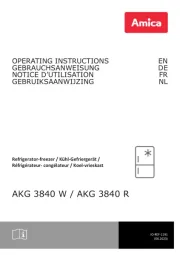
12 Oktober 2025

12 Oktober 2025
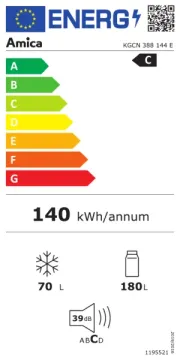
11 Oktober 2025
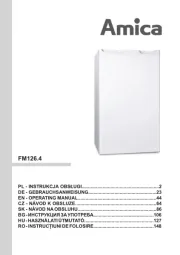
3 September 2025

3 September 2025
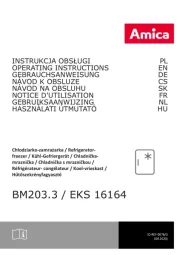
2 September 2025

2 September 2025
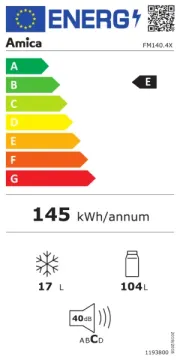
2 September 2025
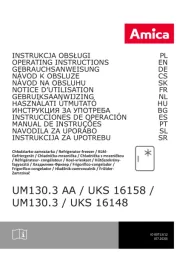
2 September 2025
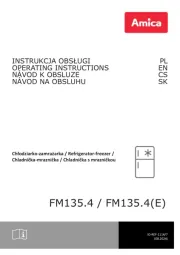
2 September 2025
kylskåp Manualer
- Snaigė
- Corberó
- KitchenAid
- Fulgor Milano
- Randell
- Corona
- LERAN
- XD Enjoy
- Cata
- Federal
- Pyle
- APW Wyott
- Cecilware
- Nordland
- Changhong
Nyaste kylskåp Manualer
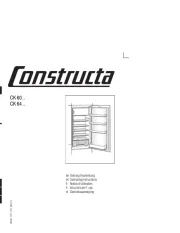
23 Oktober 2025
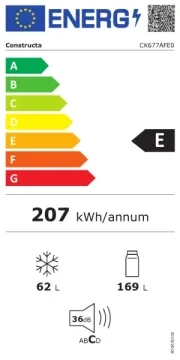
23 Oktober 2025
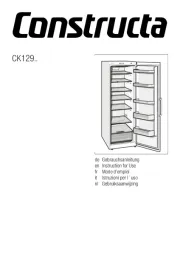
23 Oktober 2025

23 Oktober 2025

23 Oktober 2025
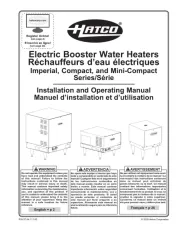
23 Oktober 2025

21 Oktober 2025
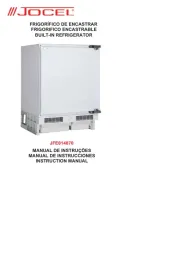
21 Oktober 2025

20 Oktober 2025

20 Oktober 2025